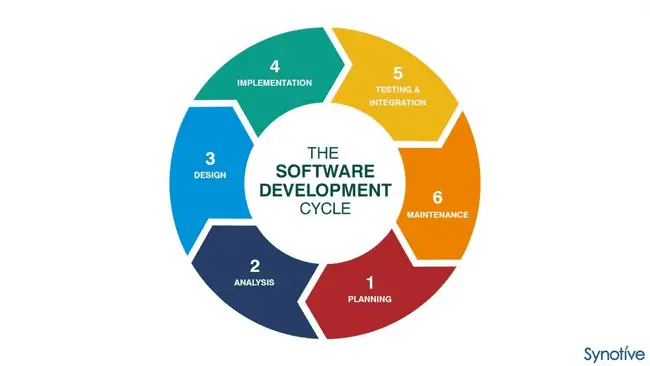The software development life cycle (SDLC) provides a structured framework to take a product from conception to deployment and maintenance. This guide provides an in-depth look at the phases, processes, models, security integration, and benefits of implementing a robust SDLC.
What is Software Development Life Cycle?
The SDLC outlines the stages involved in transforming business requirements into functional, high-quality software. It brings predictability to software delivery through standardized processes and checkpoints.
SDLC Step by Step Process
The software development life cycle (SDLC) guides the creation, delivery, and maintenance of software products. The SDLC consists of several phases, each with its own objectives, activities, and deliverables. By following the SDLC step-by-step process, you can achieve your software development goals efficiently and effectively. In the section below, we will outline the main phases of the SDLC.
Read: Things to Consider When Building a Data Warehouse
Phases of the Software Development Life Cycle – SDLC Process Steps
- Requirements gathering – Thoroughly define features, tools, budget, timelines, risks.
- System design – Create comprehensive architecture, component, and security specifications.
- Development – Build, integrate, and unit test code components based on design.
- Testing – Validate software quality and functionality through various software development life cycle testing types.
- Deployment – Package, migrate, and release system to production environments.
- Maintenance – Actively monitor issues, enhance features, and apply patches.

Well-defined SDLCs increase the likelihood of project success through reduced budget/timeline overruns and secure, quality software aligned to business objectives.
Read: A Brief Overview of Software Development Methodologies
Examining Models of Software Development Life Cycle in Depth
SDLC models provide different approaches to the software delivery stages:
Waterfall Model
The waterfall methodology sequences stages linearly in a strictly downward flow:
- Requirements – Gather detailed business, user, functional, and non-functional requirements.
- Design – Create robust technical specifications, and architecture diagrams.
- Implementation – Build code according to design documents.
- Testing – Develop test plans to validate behavior against requirements.
- Deployment – Package and migrate the system to production.
- Maintenance – Ongoing bug fixes, updates, and support.
Waterfall provides a simple, logical approach for small, well-defined projects but lacks the flexibility to change requirements after design completion.
Agile Model
Agile uses short, iterative cycles called sprints to evolve software:
- Product backlog – Prioritized list of required features.
- Sprint planning – Select backlog items for iteration.
- Sprint build – Complete coding and testing within a time-boxed sprint.
- Review – Demonstrate working functionality.
- Retrospective – Discuss process improvements.
Agile allows adapting to changing needs but can lead to technical debt and testing gaps without thorough planning.
Spiral Model – Iterative SDLC
The spiral model repeats iterative cycles with four key phases:
- Objectives – Define goals, alternatives, and constraints.
- Risk analysis – Identify and prioritize risks.
- Development & testing – Build prototypes or software increments.
- Evaluation – Review results for the next spiral.
The iterative software development life cycle approach accommodates changing requirements but development time and costs can grow exponentially without clear exit criteria.
Read : A brief guide to testing APIs & the tools involved

V-Shaped Model – Testing is part of a QA life cycle
The V-model links each development phase to a corresponding testing phase:
- Requirements – Specify functional, and performance requirements.
- High-level design – Architect major system modules.
- Low-level design – Define component-level design.
- Coding – Transform detailed design into code.
- Unit testing – Validate individual components.
- Integration testing – Verify modules interacting correctly.
- System testing – Validate entire system meets requirements.
V-model’s emphasis on test verification suits smaller, low-risk projects. The difficulty emerges when needing to change original requirements after the design is completed. This highlights the importance of the SDLC in software testing, ensuring that each stage of development is thoroughly tested and verified.
Integrating Security in SDLC phases
Given rising data breaches, building security into all software development life cycle in software testing phases is crucial:
- Requirements – Conduct threat modeling, and define security requirements.
- Design – Incorporate encryption, access controls, and secure defaults.
- Development – Validate inputs/outputs, static/dynamic analysis, and code reviews.
- Testing – Execute penetration testing and attack simulations.
- Deployment – Harden infrastructure, and establish monitoring and response plans.
- Operations – Continuous vulnerability monitoring, patching, and activity logging.
Prioritizing security in requirements, design, and testing results in inherently more secure software that protects customer data, intellectual property, and brand reputation.

Read: Selenium Automation Testing Best Practices Every QA Should Know
Examining Core Software Development Life Cycle Phases In-Depth
While models differ, common SDLC phases include:
Requirements Gathering and Analysis
Activities
- Interviews with business and technical stakeholders
- User surveys, feedback sessions
- Review of existing systems and data
- Market/competitive research
- Personas, workflow diagrams
- Acceptance criteria definition
Deliverables
- Business requirements document (BRD)
- Functional specifications document (FSD)
- User stories or use cases
- Process flows
Outcome
- Full documented business objectives, user needs, and functional/non-functional requirements
System Architecture and Design
Activities
- Map software architecture and components
- Define technology stack, tools, frameworks
- Model database schema
- API specifications
- Interface design, wireframes
- Create security and scalability designs
Deliverables
- High/low-level architecture diagrams
- Interface documentation
- Technical specification documents
Outcome
- Detailed technical blueprint matching all requirements
Software Development
Activities
- Coding based on technical design
- Documentation
- Version control
- Code reviews and standards
- Unit testing
Deliverables
- Source code
- Unit test cases
- Code review and coverage reports
Outcome
- Fully built software matching designs
Integration and Testing
Activities
- Functional/system testing
- Performance testing
- Load and stress testing
- Software development life cycle security testing
- User acceptance testing
Deliverables
- Test plans, test cases
- Testing reports
- Defect reports
Outcome
- Software validated against all requirements
Deployment
Activities
- Finalize release notes
- Configuration and infrastructure setup
- Migrations/cutovers
- Customer onboarding
- Monitoring and support readiness
Deliverables
- Deployment guides
- Configuration documentation
- Release package
Outcome
- Software successfully released and operational

Maintenance and Operations
Activities
- Corrective fixes, patches
- Respond to customer issues
- Performance monitoring
- Feature enhancements
- Sunset planning
Deliverables
- Patch releases
- Updated user guides
- Enhancement requests
Outcome
- Smooth ongoing operations and incremental improvements
Clearly defining deliverables, responsibilities, and entry/exit criteria for each phase ensures seamless SDLC transitions.

Read: How DevOps is Improving Software Development Protocols
Key Benefits of Implementing a Software Development Life Cycle
Adopting an effective, customized SDLC provides measurable business impacts:
- Improved quality through requirements validation, traceability, and testing rigor
- Lower costs by preventing late-stage changes and defects
- Faster time-to-market through process automation and streamlining
- Enhanced security through integrating controls and testing across the life cycle
- Increased customer satisfaction by aligning features to needs and preventing defects
- Better resource utilization by eliminating duplicated efforts and waste
- Accelerated innovation by allowing adjustments through iterative approaches: The beauty of the iterative model in SDLC lies in its flexibility and adaptability, allowing for changes and improvements with each cycle. However, it’s crucial to note that the software development life cycle iterative model should be carefully managed to avoid potential pitfalls.
- More predictable budgets/timelines through upfront planning and requirements analysis
- Higher product reliability through standardized processes and checkpoints
- Improved team collaboration through cross-functional visibility
Investing in SDLC best practices provides a foundation for shipping secure, robust software users love while optimizing budgets and resources.
Key Takeaways on the Software Development Life Cycle
- The SDLC provides a predictable framework for software delivery by outlining key stages
- Requirements, design, coding, testing, deployment, and maintenance are core phases
- Waterfall, agile, spiral, and V-model offer different approaches with tradeoffs
- Integrating security into all stages results in more resilient software
- In-depth requirements gathering and analysis is key for alignment
- Defining deliverables, milestones, and entry/exit criteria enables seamless transitions
- A customized SDLC tailored to organizational needs maximizes business impacts
- Benefits include reduced costs, faster delivery, improved quality, security, and customer satisfaction
Consistently implementing and improving a streamlined, secure SDLC provides the blueprint for technology teams to deliver successful software projects.
Conclusion
In conclusion, understanding the intricacies of the software development life cycle framework is pivotal for any successful software project. Various software development life cycle methodologies like Agile, Waterfall, and others provide adaptable approaches to navigate through different SDLC phases and efficiently deliver software solutions.
Exploring diverse SDLC models such as the V-shaped model and Spiral model underscores the significance of thorough planning and testing at every stage of the software development lifecycle. These models offer valuable insights into how to ensure software quality and functionality.
Incorporating the best practices of the software development lifecycle not only optimizes the development process but also contributes to enhanced software security, quality, and customer satisfaction. It’s the roadmap to achieving excellence in the dynamic world of software engineering, providing a structured path to successful project outcomes.
If you like the content, we would appreciate your support by buying us a coffee. Thank you so much for your visit and support.


